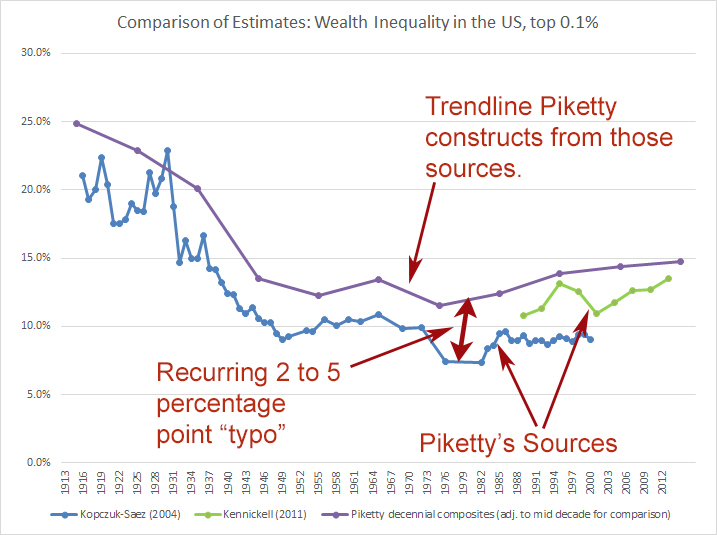On the first issue, Magness just linearly interpolated the 1960 SCF/K&S ratio to the 1920 SCF/K&S ratio and lo and behold it's very close to Piketty's result! You know why? Because that's more or less what Piketty did. This is of course not what I suggested. I didn't say interpolate between 1960 and a year we didn't even have an empirical SCF/K&S ratio - I said project the SCF/K&S ratios backwards. The decline in the ratio from the present to 1960 is much steeper than the two steps Piketty uses (first to 1.25 then to 1.20). If we are being conservative - e.g., making the decline as shallow as possible - we can project back using the smallest rate of decline in the multiplier from the 1960-2000 period which is 0.04 per decade. If you project back using that rate of decline than the difference in the wealth share in the depression decade is 2.4 percentage points - about the magnitude of a departure that Magness gets so upset about elsewhere.
The second two issues are more minor (although they still make about a percentage point difference each - which makes me think he botched something there too - put those together and it's about the magnitude that Phil got upset about elsewhere). My claim was never that they make a substantial difference - indeed I said "it only has minor effects". Phil is missing the point, which is that he's hunting for (cherry picking you might say, if he was aware of this stuff) differences that "help the narrative" without giving a full accounting of all the data decisions that in the end looks much more balanced. Of course anyone can compile a list of data decisions that make it look like he's gaming things, but if you ignore the others that starts to get suspicious.
My bigger issue is with crap like this from Phil:
"Also recall that the persons making this claim have been quite content to casually overlook multiple instances where Piketty massaged the very same data in favor of his narrative, yielding divergences of 5 percentage points (and higher) between Piketty’s constructed trend line and his claimed data sources. For an example see this wherein Piketty’s trend for the top 0.1% is compared against his raw sources:
 "
"He observes that Piketty's adjustments are different from the raw data. Sure - everyone already knows that Piketty did a lot of work adjusting and splicing the raw data. Phil's approach is to:
1. Point out something everybody knows.
2. Not do any work understanding why the adjustment occurs.
3. Publish an article alleging malpractice and even more inflammatory blog posts calling them "typos".
This is what pissed me off the most in my points 2 and 4. People have gotten unduly impressed with Magness because he spent some time this summer and fall in the technical appendix without doing any real replication work. He attacks Piketty's integrity while readily admitting that given what's in the technical appendix he actually doesn't understand why the adjustments were made.





I'm keeping an open mind here as I assume that Piketty as a leading academic would not just make stuff up - for the sake of his reputation if nothing else. Having said that it does seem odd that he makes adjustment to that trend line that move it up by 5% at one point.
ReplyDeleteJust to take this one example..
- Is what M&M say true - is the data adjusted upwards?
- What is the explanation for why this done?
(BTW & FWIW: I have never found your posts to be lacking in lucidity).
So he shifts some of the series up, often to harmonize two series as well as getting series consistent across countries. It's hard to say why every adjustment is made because not all the details are provided (though many are), and Phil generally doesn't seem willing to figure out or provide much on that front.
DeleteReally the levels are less important than the trends and the levels relative to other countries.
Yes, I agree that the levels are less important than the trends. In additional I agree that the factual errors that M&M list are not very important to the overall narrative (I am am now about 75% through the book).
DeleteIs there anything in the M&M papers that disputes the trends or are they just challenging the slope of the trend lines ?
Challenges all of the above. Some there are deeper reasons offered (such as on the communist countries), although I think it's a little silly. A lot is what I describe above where they can't figure it out from the technical appendix and just give up the hunt.
DeleteOne thing Transformer: I'm not throwing Phil under the bus, but please keep distinct "M&M" (referring to our paper) and "anything Phil says in an argument with Daniel on Facebook or his blog."
ReplyDeleteAgain, I'm not saying the points in this latest exchange of gunfire are wrong, just that on my blog for example people were talking about UK data and questioning "Murphy and Magness" when we don't get into UK data in the paper.
That was my fault on your blog, however generally I find it *very* easy to distinguish you two :)
Delete